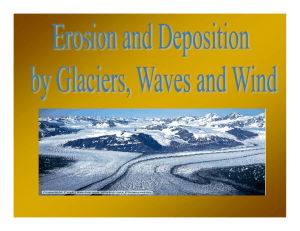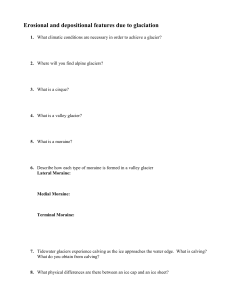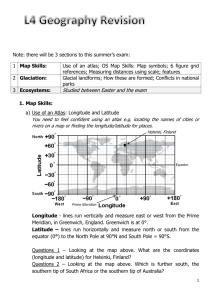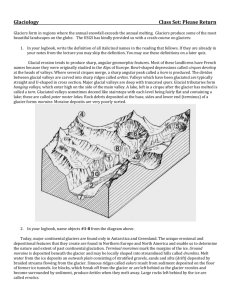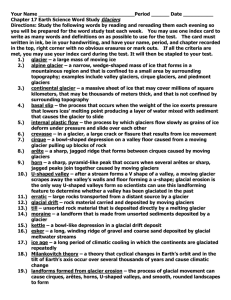Glaciation - Hillhead High School
advertisement
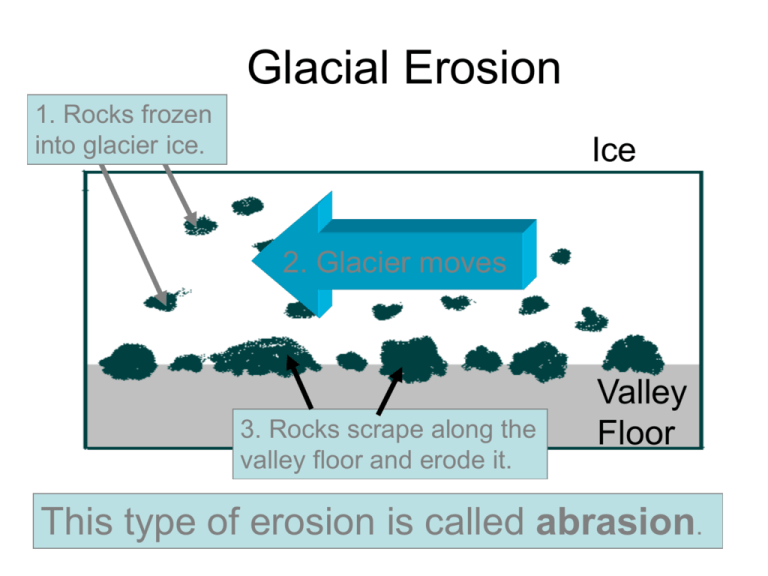
Glacial Erosion 1. Rocks frozen into glacier ice. Ice 2. Glacier moves 3. Rocks scrape along the valley floor and erode it. Valley Floor This type of erosion is called abrasion. Glacial Erosion 1. Ice freezes around bits of rock 3. Bits of rock are taken from the rock face with the ice Ice 2. The Glacier moves Rock This type of erosion is called plucking Formation of a Corrie How to answer the question: ‘Explain how a corrie was formed.’ • Mention what the shape was like before • Mention what the shape is like afterwards • Mention how the shape was changed Before Glaciation • Snow falls in a hollow high in the mountains • The snow compresses into ice During Glaciation • The ice moves downhill as a glacier •At ‘A’ freeze thaw weathering makes the backwall steeper and jagged •At ‘B’ plucking makes the backwall steeper and jagged A B C •At ‘C’ abrasion deepens and smoothes the hollow For full credit marks mention how abrasion, plucking & freeze thaw work After Glaciation • The corrie has steep sides and steep back wall The lip is emphasised by moraine deposited by the glacier Often • The hollow is deeper water fills the corrie known as a tarn 1. Two Glaciers erode back to back into a mountain by plucking as they move downhill. 2. This forms 2 corries. 3. Plucking makes the ridge narrower and this is called an Arete. 4. Freeze-thaw weathering makes the Arete sharper 1. Where glaciers start in a hollow they move downhill and erode by plucking and abrasion to form corries. 2. Three or more corries form back to back or side by side 3. Where the corrie sidewalls meet they form ridges which become narrower by plucking. 4. These are called Aretes. Three Arêtes meet to form a pyramidal peak 5. The peak becomes sharper by freeze-thaw weathering Formation of U-shaped valley Before glaciation a v-shaped valley During the ice age a glacier moves down the valley. Rocks trapped in the bottom of the ice act like sandpaper wearing away the valley by abrasion. The glacier deepens, straightens and widens the valley by abrasion. After the ice melts a U-Shaped valley remains After Glaciation there is sometimes a misfit stream or ribbon lake in the bottom of the valley 1. Erosion in the main glacier is far greater making a deeper valley. Map View 2. Erosion in the tributary glaciers is less making a shallower valley. 3. The shallower valleys are left ‘hanging’ above the deeper main valley. 4. Waterfalls often fall over the edge at the end of the hanging valley into the main valley. 5. At the base of a waterfall alluvial fans are sometimes found as a result of deposition Tributary Main valley valley Cross Section Tributary valley Main valley Ribbon Lakes 1. Glaciers move down a former v-shaped valley and erode the valley by abrasion and plucking turning the valley into a u-shape. 2. Some ribbon lakes form when the glacier meets softer rock. 3. The glacier erodes more deeply at these points. 4. After the glacier has melted the deeper parts fill with water to form ribbon lakes Ribbon Lake Hard Rock Soft Rock Hard Rock Side view of valley before Glaciation Hard Rock Soft Rock Hard Rock Side view of valley after Glaciation How Till is formed 1. The temperature rises due to climate change at the end of the ice age or the temperature rises as the glacier reaches lower land. 2. The glacier begins to melt. The snout moves back up the valley. 3. The melting ice cannot hold the rocks, gravel and sand that have been trapped in it. 4. All this material is deposited as the glacier continues to melt. 5. The moraine is all mixed up with different sizes of material. 6. Where the glacier has been it leaves behind moraine on the floor of the valley called ground moraine, till or boulder clay. Terminal Moraine Drumlins Melting Glacier Till Outwash Plain How Drumlins are formed 1. The temperature rises due to climate change at the end of the ice age. 2. The glacier begins to melt. The snout moves back up the valley. 3. The melting ice cannot hold the rocks, gravel and sand that have been trapped in it. 4. All this material is deposited as the glacier continues to melt. 5. The moraine is all mixed up with different sizes of material. 6. A large rock is deposited and traps more moraine around it forming a drumlin 7. The glacier continues to move when it is melting and makes the drumlin smooth Terminal Moraine Drumlins Melting Glacier Till Outwash Plain How Terminal Moraine is formed 1. The glacier pushes the moraine in front of it like a bulldozer 2. The temperature rises due to climate change at the end of the ice age. 3. The glacier begins to melt. The snout moves back up the valley. 4. The melting ice cannot hold the rocks, gravel and sand that have been trapped in it. 5. All this material is deposited as the glacier continues to melt. 6. The moraine is all mixed up with different sizes of material 7. The furthest point the glacier reached is marked by a ridge of material running across the valley called terminal moraine Terminal Moraine Drumlins Melting Glacier Till Outwash Plain How the outwash plain is formed 2. 3. 4. 5. The temperature rises due to climate change at the end of the ice age. The glacier begins to melt. The snout moves back up the valley and melt-water streams carry material down the valley. The outwash plain is in front of where the glacier has been and is deposited by melt-water. The outwash plain is made from sorted sands and gravels. Gravels are deposited in the spring when there is more melting. Sands are deposited in the autumn when there is less melting Drumlins Melting Glacier Till Terminal Moraine 1. Outwash Plain 1. 2. 3. 4. 5. 6. 7. 8. The temperature rises due to climate change at the end of the ice age. The glacier begins to melt. Tunnels form in the melting ice Meltwater streams flow in the tunnels Deposits are laid down along the course of where the stream has been. The snout moves back up the valley Long, winding ridges of sorted material known as eskers are left where these streams have been Gravels are deposited in the spring when there is more melting. Sands are deposited in the autumn when there is less melting How an esker is formed
